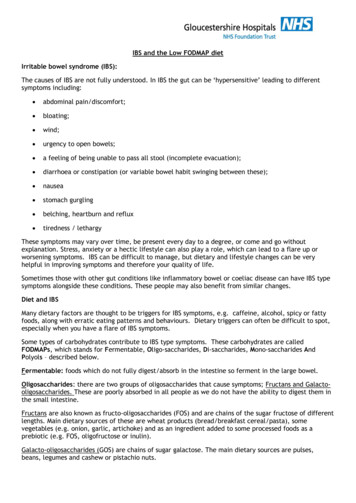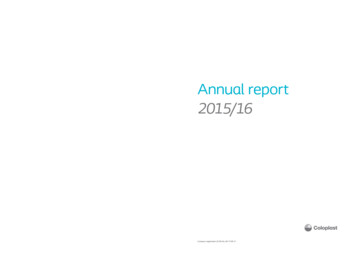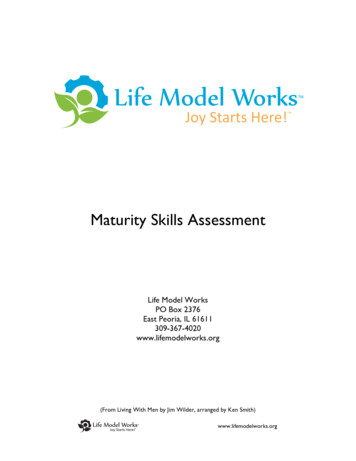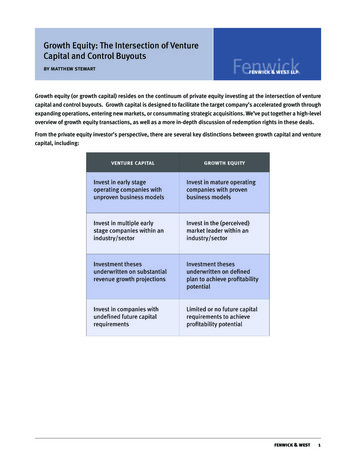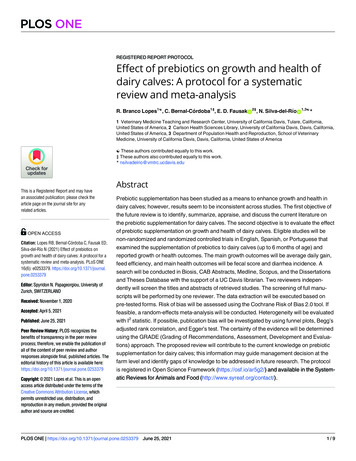
Transcription
PLOS ONEREGISTERED REPORT PROTOCOLEffect of prebiotics on growth and health ofdairy calves: A protocol for a systematicreview and meta-analysisR. Branco Lopes1 , C. Bernal-Córdoba1‡, E. D. Fausak ID2‡, N. Silva-del-Rı́o ID1,3 *1 Veterinary Medicine Teaching and Research Center, University of California Davis, Tulare, California,United States of America, 2 Carlson Health Sciences Library, University of California Davis, Davis, California,United States of America, 3 Department of Population Health and Reproduction, School of VeterinaryMedicine, University of California Davis, Davis, California, United States of 1a1111111111 These authors contributed equally to this work.‡ These authors also contributed equally to this work.* nsilvadelrio@vmtrc.ucdavis.eduAbstractThis is a Registered Report and may havean associated publication; please check thearticle page on the journal site for anyrelated articles.OPEN ACCESSCitation: Lopes RB, Bernal-Córdoba C, Fausak ED,Silva-del-Rı́o N (2021) Effect of prebiotics ongrowth and health of dairy calves: A protocol for asystematic review and meta-analysis. PLoS ONE16(6): e0253379. : Spyridon N. Papageorgiou, University ofZurich, SWITZERLANDReceived: November 1, 2020Accepted: April 5, 2021Published: June 25, 2021Peer Review History: PLOS recognizes thebenefits of transparency in the peer reviewprocess; therefore, we enable the publication ofall of the content of peer review and authorresponses alongside final, published articles. Theeditorial history of this article is available opyright: 2021 Lopes et al. This is an openaccess article distributed under the terms of theCreative Commons Attribution License, whichpermits unrestricted use, distribution, andreproduction in any medium, provided the originalauthor and source are credited.Prebiotic supplementation has been studied as a means to enhance growth and health indairy calves; however, results seem to be inconsistent across studies. The first objective ofthe future review is to identify, summarize, appraise, and discuss the current literature onthe prebiotic supplementation for dairy calves. The second objective is to evaluate the effectof prebiotic supplementation on growth and health of dairy calves. Eligible studies will benon-randomized and randomized controlled trials in English, Spanish, or Portuguese thatexamined the supplementation of prebiotics to dairy calves (up to 6 months of age) andreported growth or health outcomes. The main growth outcomes will be average daily gain,feed efficiency, and main health outcomes will be fecal score and diarrhea incidence. Asearch will be conducted in Biosis, CAB Abstracts, Medline, Scopus, and the Dissertationsand Theses Database with the support of a UC Davis librarian. Two reviewers independently will screen the titles and abstracts of retrieved studies. The screening of full manuscripts will be performed by one reviewer. The data extraction will be executed based onpre-tested forms. Risk of bias will be assessed using the Cochrane Risk of Bias 2.0 tool. Iffeasible, a random-effects meta-analysis will be conducted. Heterogeneity will be evaluatedwith I2 statistic. If possible, publication bias will be investigated by using funnel plots, Begg’sadjusted rank correlation, and Egger’s test. The certainty of the evidence will be determinedusing the GRADE (Grading of Recommendations, Assessment, Development and Evaluations) approach. The proposed review will contribute to the current knowledge on prebioticsupplementation for dairy calves; this information may guide management decision at thefarm level and identify gaps of knowledge to be addressed in future research. The protocolis registered in Open Science Framework (https://osf.io/ar5g2/) and available in the Systematic Reviews for Animals and Food (http://www.syreaf.org/contact/).PLOS ONE https://doi.org/10.1371/journal.pone.0253379 June 25, 20211/9
PLOS ONEData Availability Statement: All relevant data fromthis study will be made available upon studycompletion.Funding: This project was supported by CaliforniaDepartment of Food and Agriculture - AntimicrobialUse Stewardship Program. No additional externalfunding was received for this study.Competing interests: The authors have declaredthat no competing interests exist.Prebiotics on growth and health of dairy calvesBackgroundIn dairy production systems, successful calf rearing is of upmost importance for the long-termprofitability of the operation. Growth rate and health status of dairy calves have been associated with cow’s future reproductive and productive performance [1–3]. However, raisinghealthy calves under our current management systems is challenging. In the US, the morbidityand mortality of preweaned calves reach 38% and 5%, respectively [4]. Supplementation offeed additives is a commonly adopted management strategy for dairy calves [4], that aims toimprove growth rate and immunocompetence during this critical stage of life.Prebiotics are feed additives that have been associated with an enhancement of growth performance and health status by modulating gut microbiota [5]. The International ScientificAssociation for Probiotics and Prebiotics defined prebiotic as “substrate that is selectively utilized by host microorganisms conferring a health benefit” [6]. Currently, the most known prebiotics are carbohydrate-based, specially oligosaccharides as fructo-oligosaccharides (FOS),galacto-oligosaccharides (GOS) and mannan-oligosaccharides (MOS) [7]. However, recentlyother substances as polysaccharides (e.g., xylans, pectins, inulins) and non-carbohydrate compounds (e.g., polyphenols, polyunsaturated fatty acids) have also been considered as prebiotics[8–10].The efficacy of prebiotic supplementation in dairy calves seems inconsistent in the literature. Some studies have suggested that supplementing prebiotics (MOS and polysaccharides)to calves improves average daily gain and feed efficiency and decreases fecal shedding of pathogens [11–13]. Moreover, a meta-analysis indicated that MOS (commercial product BioMos1) supplementation for dairy calves resulted in improved body weight gain [14]. However, recent evidence suggests that prebiotic supplementation (MOS and polysaccharides) hasno effect on health or growth performance of calves [15–17]. At the present, it is lacking acomprehensive and updated systematic review or meta-analysis on the effect of prebiotics ondairy calves’ growth rate and health. Results from the proposed study are critical to increaseour understanding on the effects of prebiotics on calves’ performance and health status. Ourresults may guide future management decision at the farm level and identify gaps of knowledgeto be addressed in prospective research studies.ObjectivesThe first objective of the future review is to identify, summarize, appraise, and discuss the current literature on prebiotic supplementation for dairy calves. The second objective is to evaluate the effect of prebiotic supplementation on the growth and health of dairy calves.Research questionThe research question that will be addressed in the future was developed based on the PICO(population, intervention, comparator, and outcomes) elements [8]. The question will be: doesthe prebiotic supplementation affect the growth or health of dairy calves younger than 6months?MethodsThe reporting of this review protocol is in accordance to the Preferred Reporting Items for Systematic Review and Meta-Analysis Protocols (PRISMA-P) statement [18] and followed theguidelines for systematic review in animal agriculture and veterinary medicine [19]. The protocol is registered in Open Science Framework (https://osf.io/ar5g2/) and available in the SYREAF (Systematic Reviews for Animals and Food; http://www.syreaf.org/contact/), which is anPLOS ONE https://doi.org/10.1371/journal.pone.0253379 June 25, 20212/9
PLOS ONEPrebiotics on growth and health of dairy calvesonline repository for publication of review protocols studying animals and food. The PRISMA-P checklist is included in S1 Table. Although not intended, any amendments to this protocol will be documented and justified in the final review manuscript.Eligibility criteriaAs the research question, the eligibility criteria were defined based on the PICO elements.Study design, characteristics, and populationThe systematic review will include primary research studies, including non-randomized andrandomized controlled trials, which are available in English, Spanish, and Portuguese. Observational studies will be excluded. Eligible studies must have investigated pre-weaned orweaned dairy calves (up to 6 months of age), with no restrictions on calves’ breed or sex. Norestriction on publication date or publication status will be applied; however, manuscriptslacking primary data will be excluded.Intervention and comparator groupsEligible studies must have evaluated prebiotic supplementation, with no restriction for prebiotic type, dose, or supplementation duration. Research studies assessing prebiotics as therapyto control or treat diseases will be excluded. The prebiotic supplementation must have beencompared to no intervention or placebo. Studies evaluating positive control groups (e.g., antimicrobials) as the single comparator will be excluded.Outcome measuresStudies must include at least one main or secondary outcome. For growth, the main outcomeswill include average daily gain and feed efficiency, while secondary outcomes will be bodyweight, body traits (e.g., heart girth, wither height, hip width, or body length), dry matterintake and rumen development indicators (e.g., volatile fatty acids, ruminal pH, papilla length,and papilla width). For health, the main outcomes will comprise fecal score and diarrhea incidence, whereas assessments of serum metabolites (e.g., glucose, beta-hydroxybutyrate), immunoglobulins, cytokines, and mortality will be considered secondary outcomes. The main andsecondary outcomes are defined in S2 Table. The prioritization of the growth performanceoutcomes was based on their impact on lifetime milk production [20]. The health outcomeswere prioritized based on their association with gut health [21] and their frequency of use incalf health research studies [22].Information sourcesAfter consultation with an experienced health and veterinary science academic librarian(EDF), the following electronic databases were selected: Biosis (Web of Science, 1926 to present), CAB Abstracts (CAB Direct, 1973 to present), Medline (PubMed, 1966 to present), andScopus (Scopus, 1996 to present). Grey literature will be searched to find unpublished datausing Dissertations and Theses Database (ProQuest, 1861 to present). The bibliography of relevant studies will be hand-searched by the first author.Search strategyThe search strategy will be designed with the assistance of an academic librarian (EDF). Forthis, the first author will select key words from relevant literature. The librarian will perform akeyword and subject heading citation analysis by finding hand-selected references in PubMedPLOS ONE https://doi.org/10.1371/journal.pone.0253379 June 25, 20213/9
PLOS ONEPrebiotics on growth and health of dairy calvesand CAB Direct. Keywords and subject headings will be collected and compared with thosealready utilized. Yale MeSH analyzer will be also utilized to compare common Medical SubjectHeadings across articles for PubMed interface. Boolean operators “AND” and “OR” will beused to connect the search terms. Based on strategies built in PubMed and CAB Direct, EDFwill translated the search to the other databases: Biosis, Scopus, and Proquest Dissertationsand Theses. The refinement of the search strategy will be performed by the EDF and RBL. Apreliminary literature search was conducted on October 28th of 2020; the results are describedin S3 Table.Data managementThe retrieved studies from the search performed in each electronic database will be exportedto the reference manager F1000 (Faculty of 1000 Limited, London, UK) and duplicates will beremoved. The de-duplicated results will be exported to the Covidence systematic review management software (Veritas Health Innovation, Melbourne, AU) for title and abstract screening.The data from the studies that meet the eligibility criteria will be extracted and entered onto aMicrosoft Excel spreadsheet.Selection processAll manuscripts identified after each database search will be screened by two independentreviewers (RBL and CBC). Both reviewers have received systematic review training and havedomain-specific knowledge on animal science. None of the reviewers will be blinded to journalor author names. Text-mining tools will not be used for any screening level. Firstly, the manuscripts’ titles and abstracts will be screened. For this first screening, the following questionswill be used to identify potentially eligible studies for inclusion in the review:1. Does the title or abstract describe a study with dairy calves?2. Does the title or abstract describe a study with prebiotic supplementation?3. Does the title or abstract describe a primary intervention study?4. Does the title or abstract describe one or more of outcomes for growth (e.g., average dailygain, feed efficiency) or health (e.g., fecal score, diarrhea incidence)?For each of the screening questions the available answers will be “no,” “maybe,” and “yes.”Studies will be excluded if both reviewers responded “no” to one of the questions. In addition,only citations with “maybe” or “yes” answers will be screened in the following step. Any disagreements between reviewers will be resolved by discussion, if no consensus is reached athird reviewer will be consulted (NSDR).A full manuscript screening will be conducted by RBL on the remaining studies. Thisscreening included the 4 previous questions, plus:5. Is the study a controlled trial with negative control group?6. Is the study written in English, Spanish, or Portuguese?7. Is the prebiotic a supplementation strategy (not treatment or metaphylactic approach)?8. Is the study population (dairy calves) equal or less than 6 months old?During the full manuscript screening the answer available will be “no” and “yes.” Studieswill be excluded if RBL answer “no” for one or more of the questions. The exclusion reasonPLOS ONE https://doi.org/10.1371/journal.pone.0253379 June 25, 20214/9
PLOS ONEPrebiotics on growth and health of dairy calveswill be recorded at this screening level. A pre-test will be conducted in 30 abstracts to evaluatethe clarity of the screening questions for each screening level.Data collection processStudies that meet the eligibility criteria will be extracted by RBL into a Microsoft Excel spreadsheet. Data extraction forms will be designed based on previous studies, and pre-tested using 5studies. Additionally, to assure the accuracy and completeness of the data collection, a secondreviewer (CBC) will audit all the data entered into the extraction forms [23]. Study-level datawill consist of journal name, language, country, author’s name and affiliation, year of publication, and funding information. Population characteristics include animals’ breed, sex, age,housing (individual or group), production system (conventional or organic), assessment ofpassive transfer, and herd type (commercial or research). Intervention and comparator datawill include the description of comparator, prebiotic’s commercial name, scientific name, concentration, dose, form of administration (e.g., whole milk, milk replacer), and duration of supplementation. For continuous outcomes (e.g., average daily gain), the following informationwill be extracted: number of experimental units for each treatment group, least square or contrast means for each treatment group, mean differences from control, unit of results, lowerand upper 95% confidence intervals (CI), standard error, standard deviation, P-value, and thetime point of each measurement. For dichotomous outcomes (e.g., occurrence of diarrhea),the following information will be extracted: number and proportion of positive experimentalunits per treatment group, total number of experimental units per treatment group, unit ofresults, odds ratio, relative risk, lower and upper 95% CI, P-value, and the time point of eachmeasurement.Risk of bias assessmentThe risk of bias will be assessed at the outcome level by RBL, using the Cochrane Risk of Bias2.0 tool (Sterne et al., 2019) [24], with adaptations in the signaling questions to fit the animalscience. The following domains of bias will be assessed: a) randomization process, b) deviations from intended interventions, c) missing outcome data, d) measurement of the outcome,and e) selection of the reported result. In the randomization process domain, the allocationsequence is unlikely that a farm worker or a researcher would have any treatment preferencefor a specific calf; thus, the question “will be the allocation sequence concealed until participants will be enrolled and assigned to interventions?” will be dropped. In the deviations fromintended interventions domain, the question “will be participants aware of their assignedintervention during the trial?” will be dropped, as dairy calves are the population of interest;we will assume that in all trials calves were blinded. A similar approach has been described in aprevious systematic review assessing risk of bias in livestock studies [25]. For each domain, therisk of bias will be classified as “high,” “some concerns,” or “low”.Data synthesisIf more than 3 studies evaluate similar treatments and outcomes, a meta-analysis will be conducted. Meta-analysis will be performed in R 4.0.3 (R Foundation for Statistical Computing,Vienna, Austria) using RStudio version 1.3.1093 (RStudio Inc., Boston, MA) with the “metafor” package [26]. A random-effects model will be adopted; we will assume that not all intervention effects are the same. The weight of each study will be determined by the inversevariance method [27]. Heterogeneity between studies will be assessed by calculation of the I2statistic [28], which varies from 0 to 100% and will be interpreted as following: 0% to 40%:might not be important, 30% to 60%: may represent moderate heterogeneity, 50% to 90%: mayPLOS ONE https://doi.org/10.1371/journal.pone.0253379 June 25, 20215/9
PLOS ONEPrebiotics on growth and health of dairy calvesrepresent substantial heterogeneity, and 75% to 100%: suggests considerable heterogeneity[29]. If detected heterogeneity is higher than 50%, the possible sources of heterogeneity will beinvestigated through subgroup and sensitivity analyses. A sub-group analysis will be performed categorizing the studies as pre- or post-weaning and according to prebiotic supplementation dosage, type, and duration. If at least 10 manuscripts report similar treatments andoutcomes, publication bias will be investigated using funnel plots, Begg’s adjusted rank correlation, and Egger’s test (P 0.10). If publication bias is detected, the “trim-and-fill” methodwill be used to estimate the extent of the bias [30]. If less than 3 studies meet the eligibility criteria or if the heterogeneity of the intervention and outcomes of the eligible studies is highresults will be presented descriptively.Confidence in cumulative evidenceThe certainty of the evidence will be assessed by one reviewer (RBL) using the GRADE (Grading of Recommendations, Assessment, Development and Evaluations) approach [31]. GRADEappraises the certainty of the body of evidence gathered in a systematic review. The evidencewill be evaluated based on risk of bias, imprecision, inconsistency, indirectness, and publication bias.DiscussionThe presence of microorganisms in the intestine of calves is considered a co-evolution process[32]. The calves’ intestinal microbiota plays diverse functions such as protection against pathogens, activation of immune systems and, contributes to their nutrition [33]. Thus, it has beenhypothesized that the manipulation of the microbiota through prebiotic supplementation mayenhance the growth and health of dairy calves. To test this hypothesis, the future systematicreview and meta-analysis will summarize and assess the effect of prebiotics on the growth andhealth of dairy calves. If prebiotics are found to impact the growth or health of dairy calves, theresults from the future study may be useful guidelines for dairy consultants and veterinarians.In addition, the findings will contribute to the current knowledge on prebiotic supplementation in dairy calves and may be informative to guide future research. The proposed review hasseveral strengths; it will adhere to the guidelines for systematic reviews in animal agricultureand veterinary medicine [34,35], the search strategy will be designed with librarian support inorder to identify the highest number of available studies. To minimize bias, the screening oftitles and abstracts will de performed indenpently by two reviewers, and pre-test forms will beused for each screening level. Some of the anticipated limitations of the present study aresource of heterogeneity across studies. These could include the prebiotics’ viability, type, anddosage, trials season, study design of primary litterature and settings in which the trials wereundertaken [22].Supporting informationS1 Table. PRISMA-P (Preferred Reporting Items for Systematic review and Meta-AnalysisProtocols) 2015 checklist: Recommended items to address in a systematic review protocol.(DOCX)S2 Table. Definition of main and secondary outcomes.(DOCX)S3 Table. Preliminary electronic search string used to retrieve studies examining supplementation of prebiotics for dairy calves on October 28th of 2020.(DOCX)PLOS ONE https://doi.org/10.1371/journal.pone.0253379 June 25, 20216/9
PLOS ONEPrebiotics on growth and health of dairy calvesAuthor ContributionsConceptualization: R. Branco Lopes, N. Silva-del-Rı́o.Funding acquisition: N. Silva-del-Rı́o.Methodology: R. Branco Lopes, E. D. Fausak.Project administration: N. Silva-del-Rı́o.Resources: E. D. Fausak.Supervision: N. Silva-del-Rı́o.Validation: C. Bernal-Córdoba.Visualization: R. Branco Lopes.Writing – original draft: R. Branco Lopes.Writing – review & editing: C. Bernal-Córdoba, N. Silva-del-Rı́o.References1.Krpálková L, Cabrera VE, Kvapilı́k J, Burdych J, Crump P. Associations between age at first calving,rearing average daily weight gain, herd milk yield and dairy herd production, reproduction, and profitability. J Dairy Sci. 2014; 97: 6573–6582. https://doi.org/10.3168/jds.2013-7497 PMID: 250646572.Soberon F, Raffrenato E, Everett RW, Van Amburgh ME. Preweaning milk replacer intake and effectson long-term productivity of dairy calves. J Dairy Sci. 2012; 95: 783–793. https://doi.org/10.3168/jds.2011-4391 PMID: 222813433.Heinrichs AJ, Heinrichs BS. A prospective study of calf factors affecting first-lactation and lifetime milkproduction and age of cows when removed from the herd. J Dairy Sci. 2011; 94: 336–341. https://doi.org/10.3168/jds.2010-3170 PMID: 211830434.Urie NJ, Lombard JE, Shivley CB, Kopral CA, Adams AE, Earleywine TJ, et al. Preweaned heifer management on US dairy operations: Part I. Descriptive characteristics of preweaned heifer raising practices. J Dairy Sci. 2018; 101: 9168–9184. https://doi.org/10.3168/jds.2017-14010 PMID: 299088155.Cangiano LR, Yohe TT, Steele MA, Renaud DL. Invited Review: Strategic use of microbial-based probiotics and prebiotics in dairy calf rearing. Appl Anim Sci. 2020; 36: 1–21. https://doi.org/10.15232/aas.2020-020496.Gibson GR, Hutkins R, Sanders ME, Prescott SL, Reimer RA, Salminen SJ, et al. Expert consensusdocument: The International Scientific Association for Probiotics and Prebiotics (ISAPP) consensusstatement on the definition and scope of prebiotics. Nat Rev Gastroenterol Hepatol. 2017; 14: 491–502.https://doi.org/10.1038/nrgastro.2017.75 PMID: 286114807.Uyeno Y, Shigemori S, Shimosato T. Effect of Probiotics/Prebiotics on Cattle Health and Productivity.MICROBES Environ. 2015; 30: 126–132. https://doi.org/10.1264/jsme2.ME14176 PMID: 260047948.Moorthy M, Chaiyakunapruk N, Jacob SA, Palanisamy UD. Prebiotic potential of polyphenols, its effecton gut microbiota and anthropometric/clinical markers: A systematic review of randomised controlled trials. Trends Food Sci Technol. 2020; 99: 634–649. tini L, Molinari R, Farinon B, Merendino N. Impact of omega-3 fatty acids on the gut microbiota.Int J Mol Sci. 2017; 18: 2645–2662. https://doi.org/10.3390/ijms18122645 PMID: 2921558910.Scott KP, Grimaldi R, Cunningham M, Sarbini SR, Wijeyesekera A, Tang MLK, et al. Developments inunderstanding and applying prebiotics in research and practice—an ISAPP conference paper. J ApplMicrobiol. 2020; 128: 934–949. https://doi.org/10.1111/jam.14424 PMID: 3144666811.Ghosh S, Mehla RK. Influence of dietary supplementation of prebiotics (mannanoligosaccharide) on theperformance of crossbred calves. Trop Anim Health Prod. 2012; 44: 617–622. https://doi.org/10.1007/s11250-011-9944-8 PMID: 2180530712.Heinrichs AJ, Jones CM, Heinrichs BS. Effects of mannan oligosaccharide or antibiotics in neonataldiets on health and growth of dairy calves. J Dairy Sci. 2003; 86: 4064–4069. https://doi.org/10.3168/jds.S0022-0302(03)74018-1 PMID: 1474084513.Roodposhti PM, Dabiri N. Effects of probiotic and prebiotic on average daily gain, fecal shedding ofEscherichia coli, and immune system status in newborn female calves. Asian-Australasian J Anim Sci.2012; 25: 1255–1261. https://doi.org/10.5713/ajas.2011.11312 PMID: 25049688PLOS ONE https://doi.org/10.1371/journal.pone.0253379 June 25, 20217/9
PLOS ONEPrebiotics on growth and health of dairy calves14.Berge AC. A meta-analysis of the inclusion of Bio-Mos in milk or milk replacer fed to dairy calves ondaily weight gain in the pre-weaning period. J Anim Res Nutr. 2016; 01. https://doi.org/10.21767/25725459.10002015.da Silva JT, Bittar CMM, Ferreira LS. Evaluation of mannan-oligosaccharides offered in milk replacersor calf starters and their effect on performance and rumen development of dairy calves. Rev Bras Zootec. 2012; 41: 746–752. Froehlich KA, Abdelsalam KW, Chase C, Koppien-Fox J, Casper DP. Evaluation of essential oils andprebiotics for newborn dairy calves. J Anim Sci. 2017; 95: 3772–3782. https://doi.org/10.2527/jas.2017.1601 PMID: 2880590717.Tóth S, Kovács M, Bóta B, Szabó-Fodor J, Bakos G, Fébel H. Effect of mannanoligosaccharide (MOS)and inulin supplementation on the performance and certain physiological parameters of calves rearedon milk replacer. J Appl Anim Res. 2020; 48: 228–234. her D, Shamseer L, Clarke M, Ghersi D, Liberatı̂ A, Petticrew M, et al. Preferred reporting items forsystematic review and meta-analysis protocols (PRISMA-P) 2015 statement. Syst Rev. 2015; 4: 1–9.https://doi.org/10.1186/2046-4053-4-1 PMID: 2555424619.O’Connor AM, Anderson KM, Goodell CK, Sargeant JM. Conducting Systematic Reviews of Intervention Questions I: Writing the Review Protocol, Formulating the Question and Searching the Literature.Zoonoses Public Health. 2014; 61: 28–38. https://doi.org/10.1111/zph.12125 PMID: 2490599420.Soberon F. and Van Amburgh M. E. The effect of nutrient intake from milk or milk replacer of preweaneddairy calves on lactation milk yield as adults: A meta-analysis of current data. J Anim Sci. 2013; 91:706–712. https://doi.org/10.2527/jas.2012-5834 PMID: 2329682321.Ma T, Villot C, Renaud D, Skidmore A, Chevaux E, Steele M, et al. Linking perturbations to temporalchanges in diversity, stability, and compositions of neonatal calf gut microbiota: prediction of diarrhea.ISME J. 2020; 14: 2223–2235. https://doi.org/10.1038/s41396-020-0678-3 PMID: 3244481222.Signorini ML, Soto LP, Zbrun MV, Sequeira GJ, Rosmini MR, Frizzo LS. Impact of probiotic administration on the health and fecal microbiota of young calves: A meta-analysis of randomized controlled trialsof lactic acid bacteria. Res Vet Sci. 2012; 93: 250–258. https://doi.org/10.1016/j.rvsc.2011.05.001PMID: 2162042823.Matz CJ, Egyed M, Hocking R, Seenundun S, Charman N, Edmonds N. Human health effects of trafficrelated air pollution (TRAP): A scoping review protocol. Syst Rev. 2019; 8: 1–5. https://doi.org/10.1186/s13643-018-0916-1 PMID: 3060625624.Sterne JAC, Savović J, Page MJ, Elbers RG, Blencowe NS, Boutron I, et al. RoB 2: A revised tool forassessing risk of bias in randomised trials. BMJ. 2019; 366. https://doi.org/10.1136/bmj.l4898 PMID:3146253125.Sargeant JM, Bergevin MD, Churchill K, Dawkins K, Deb B, Dunn J, et al. The efficacy of antibiotics tocontrol colibacillosis in broiler poultry: A systematic review. Anim Health Res Rev. 2019; 0264 PMID: 3208112626.Viechtbauer W. Conducting meta-analyses in R with the metafor. J Stat Softw. 2010; 36: 1–48. https://doi.org/10.18637/jss.v036.i0327.Borenstein M, Hedges LV, Higgins JPT, Rothstein HR. A basic introduction to fixed-effect and randomeffects models for meta-analysis. Res Synth Methods. 2010; 1: 97–111. https://doi.org/10.1002/jrsm.12PMID: 2606137628.Higgins JPT, Thompson SG, Deeks JJ, Altman DG. Measuring inconsistency in meta-analyses Testingfor heterogeneity. BMJ. 2003; 327: 557–560. https://doi.org/10.1136/bmj.327.7414.557 PMID:1295812029.Higgins J.P.T., Thomas J., Chandler J., Cumpston M., Li T., Page M.J. WVA, editor. Cochrane Handbook for Systematic Reviews of Interventions. Second. Cochrane Handbook for Systematic Reviews ofInterventions. Oxford, UK: John Wiley & Sons; 2019. https://doi.org/10.1002/978111953660430.Duval S, Tweedie R. Trim and Fill: A Simple Funnel-Plot-Based Method of Testing and Adjusting forPublication Bias in Meta-Analy
REGISTERED REPORT PROTOCOL Effect of prebiotics on growth and health of dairy calves: A protocol for a systematic review and meta-analysis R. Branco Lopes1 , C. Bernal-Co rdoba1‡, E. D. Fausak ID 2‡, N. Silva-del-Rı o ID 1,3 * 1 Veterinary Medicine Teaching and Research Center, University of California Davis, Tulare, California, United States of America, 2 Carlson Health Sciences .




